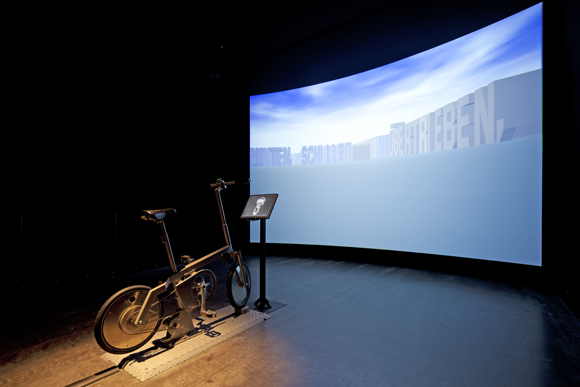|
The Legible City, 1989-1991
Jeffrey Shaw

The Legible City is one of the major works of the Australian media artist Jeffrey Shaw and a milestone of 1990s interactive media art. In this installation, the spectator rides a stationary bicycle in a dark room, experiencing a virtual journey through projected city views of Manhattan, Amsterdam and Karlsruhe. The buildings of the city take on the form of large three-dimensional letters, which go on to form words and sentences with a literary or historical connection to the location displayed. Thus the viewing of a city becomes an experience in reading, which each visitor can shape according to his wishes. The real physical exertion on the bicycle is converted into the virtual distance covered.
Since the beginning of his career, one of Jeffrey Shaw’s main preoccupations has been the overcoming of the traditional, institutionally laid-down distance between the artwork and the viewer. In this regard, Shaw’s early work was heavily influenced by the principles of Expanded Cinema, a movement in the 1960s and 1970s which opened up the work to the spectator’s participation. In all of his work, Shaw, who originally studied sculpture, shows a preference for sculptural immersion. This was the case in his monumental pneumatic sculptures, which often became the surface for projections, and which he made in the 1970s as a member of the collective Eventstructure Research Group. Here the aim was to enable the viewer to be a co-creator. Shaw sees Virtual Reality, like Expanded Cinema, as a means of drawing the spectator into the work. From the mid-1970s on, Shaw moved over to computer-based work, seeing the computer as a particularly efficient medium for his work since programmed software configurations could function as modules. These then need only to be adjusted in order to form part of further, different artworks (for example, from The Legible City to The Virtual Museum, 1991).
Conservation measures
The case study on Jeffrey Shaw’s Legible City illuminates numerous facets of the conservation of digital media art. On the one hand, the interactive installation is based on proprietary, work-specific software. On the other hand, it uses obsolete hardware and custom-made components. Both factors contribute to the high cost of maintaining this work.
Until now, for Legible City, the ZKM has held to the preservation strategy of “hardware preservation” (see the Glossary). At considerable cost, examples of the computer Indigo 2 (manufacturer: Silicon Graphics), which has been commercially unavailable since 1997, were kept and maintained. In the context of the case study’s investigations, it became clear that the specially-built analog-digital transformer was a potential weak point. This transformer forms the interface between the computer and the analog signals of bicycle. As a result, it was examined, documented and a fully-functional replica was created. The interactivity intended as part of the installation was also carefully recorded.
After the back up of data relevant to the work, the backup copies created were tested. In addition, Gideon May was interviewed on the best preservation techniques for the work – May was commissioned by Shaw in 1989 to program the installation (programming language: C). As an optional measure, May suggested “porting” the software, a process entailing the transfer of a program to another operating system. This alternative brings with it high costs in financial and human resources, but in view of the aging of the SGI computer, it offers a better long-term solution. It is currently being considered by the ZKM.
Photo: ONUK
|